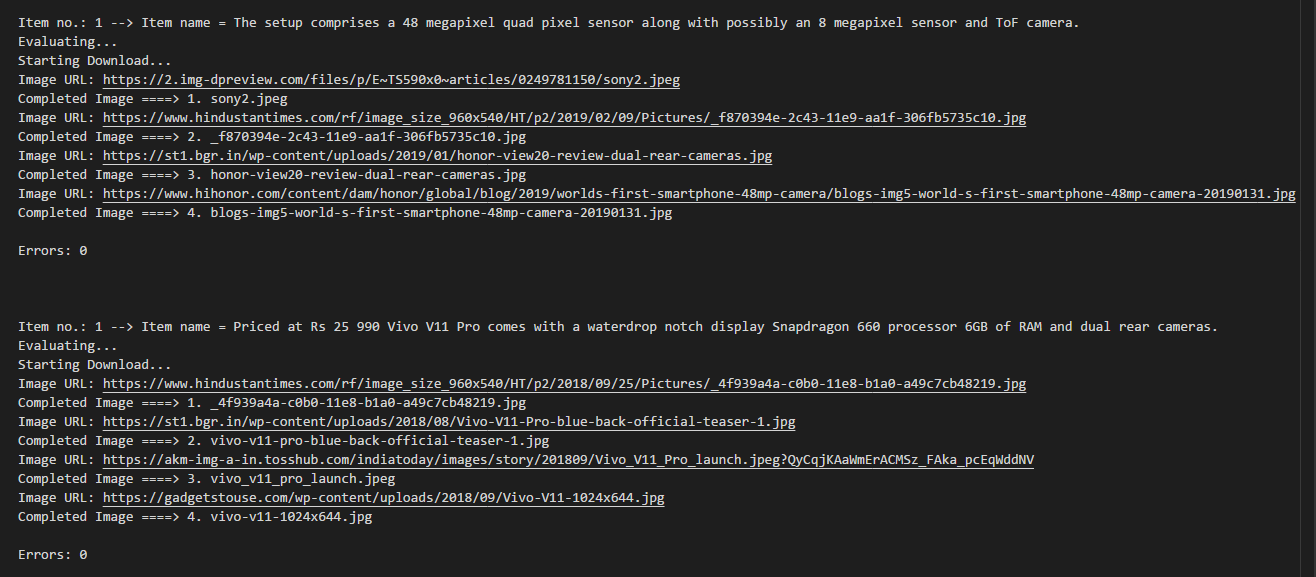1.网络获取Google图像
1.1 google_images_download
Python 是一种多用途语言,广泛用于脚本编写。我们可以编写 Python 脚本来自动化日常事务。假设我们要下载具有多个搜索查询的谷歌图片。我们可以自动化该过程,而不是手动进行。
如何安装所需的模块:
|
1
|
pip install google_images_download |
让我们看看如何编写 Python 脚本以使用 Python google_images_download 模块下载 Google 图像。
|
1
2
3
4
5
6
7
8
9
10
11
12
13
14
15
16
17
18
19
20
21
22
23
24
25
26
27
28
29
30
31
32
33
34
35
36
37
38
39
40
41
42
43
44
45
46
47
48
49
50
51
52
53
54
|
# importing google_images_download modulefrom google_images_download import google_images_download# creating objectresponse = google_images_download.googleimagesdownload()search_queries =['The smartphone also features an in display fingerprint sensor.','The pop up selfie camera is placed aligning with the rear cameras.','''In terms of storage Vivo V15 Pro could offerup to 6GB of RAM and 128GB of onboard storage.''','The smartphone could be fuelled by a 3 700mAh battery.',]def downloadimages(query): # keywords is the search query # format is the image file format # limit is the number of images to be downloaded # print urs is to print the image file url # size is the image size which can # be specified manually ("large, medium, icon") # aspect ratio denotes the height width ratio # of images to download. ("tall, square, wide, panoramic") arguments = {"keywords": query, "format": "jpg", "limit":4, "print_urls":True, "size": "medium", "aspect_ratio":"panoramic"} try: response.download(arguments) # Handling File NotFound Error except FileNotFoundError: arguments = {"keywords": query, "format": "jpg", "limit":4, "print_urls":True, "size": "medium"} # Providing arguments for the searched query try: # Downloading the photos based # on the given arguments response.download(arguments) except: pass# Driver Codefor query in search_queries: downloadimages(query) print() |
输出


注意:由于下载错误,部分图片无法打开。
1.2 BeautifulSoup
|
1
2
3
4
5
6
7
8
9
10
11
12
13
14
15
16
17
18
19
20
21
22
|
import reimport requestsfrom bs4 import BeautifulSoupfrom urllib.parse import urlparseimport osf = open("images_flowers.txt", "w")res=[]def download_google(url): #url = 'https://www.google.com/search?q=flowers&sxsrf=ALeKk00uvzQYZFJo03cukIcMS-pcmmbuRQ:1589501547816&source=lnms&tbm=isch&sa=X&ved=2ahUKEwjEm4LZyrTpAhWjhHIEHewPD1MQ_AUoAXoECBAQAw&biw=1440&bih=740' page = requests.get(url).text soup = BeautifulSoup(page, 'html.parser') for raw_img in soup.find_all('img'): link = raw_img.get('src') res.append(link) if link: f.write(link +"\n")download_google('https://www.google.com/search?q=flowers&sxsrf=ALeKk00uvzQYZFJo03cukIcMS-pcmmbuRQ:1589501547816&source=lnms&tbm=isch&sa=X&ved=2ahUKEwjEm4LZyrTpAhWjhHIEHewPD1MQ_AUoAXoECBAQAw&biw=1440&bih=740')f.close() |
1.3 pyimagesearch
感谢 Adrian Rosebrock 编写此代码并将其公开。
|
1
2
3
4
5
6
7
8
9
10
11
12
13
14
15
16
17
18
19
20
21
22
23
24
25
26
27
28
29
30
31
32
33
34
35
36
37
38
39
40
41
42
43
44
45
46
47
48
49
50
51
52
53
54
55
56
57
58
59
60
61
62
63
64
65
66
67
68
69
|
# USAGE# python download_images.py --urls urls.txt --output images/santa# import the necessary packagesfrom imutils import pathsimport argparseimport requestsimport cv2import os# construct the argument parse and parse the argumentsap = argparse.ArgumentParser()ap.add_argument("-u", "--urls", required=True, help="path to file containing image URLs")ap.add_argument("-o", "--output", required=True, help="path to output directory of images")args = vars(ap.parse_args())# grab the list of URLs from the input file, then initialize the# total number of images downloaded thus farrows = open(args["urls"]).read().strip().split("\n")total = 0# loop the URLsfor url in rows: try: # try to download the image r = requests.get(url, timeout=60) # save the image to disk p = os.path.sep.join([args["output"], "{}.jpg".format( str(total).zfill(8))]) f = open(p, "wb") f.write(r.content) f.close() # update the counter print("[INFO] downloaded: {}".format(p)) total += 1 # handle if any exceptions are thrown during the download process except: print("[INFO] error downloading {}...skipping".format(p))# loop over the image paths we just downloadedfor imagePath in paths.list_images(args["output"]): # initialize if the image should be deleted or not delete = False # try to load the image try: image = cv2.imread(imagePath) # if the image is `None` then we could not properly load it # from disk, so delete it if image is None: print("None") delete = True # if OpenCV cannot load the image then the image is likely # corrupt so we should delete it except: print("Except") delete = True # check to see if the image should be deleted if delete: print("[INFO] deleting {}".format(imagePath)) os.remove(imagePath) |
2.网络获取Youtube视频
如何安装所需的模块:
|
1
|
pip install pytube3 |
|
1
2
3
4
5
6
7
8
9
10
11
12
13
14
15
16
17
18
19
20
21
22
23
24
25
26
27
28
29
30
31
32
33
34
35
36
37
38
39
40
41
42
43
44
45
46
47
48
49
50
51
52
53
54
55
56
57
58
59
60
61
62
63
64
65
66
67
68
69
70
71
72
73
74
75
76
77
78
79
80
81
82
83
84
85
86
87
88
89
90
91
92
93
94
95
96
97
98
|
import cv2from collections import defaultdictimport matplotlib.pyplot as plt import numpy as npimport pandas as pdimport warningsfrom pytube import YouTubewarnings.filterwarnings('ignore')video = YouTube('https://www.youtube.com/watch?v=GTkU4qj6v7g')# print(video.streams.all())print(video.streams.filter(file_extension = "mp4").all())# [<Stream: itag="18" mime_type="video/mp4" res="360p" fps="30fps" vcodec="avc1.42001E" acodec="mp4a.40.2" progressive="True" type="video">,# <Stream: itag="22" mime_type="video/mp4" res="720p" fps="30fps" vcodec="avc1.64001F" acodec="mp4a.40.2" progressive="True" type="video">,# <Stream: itag="137" mime_type="video/mp4" res="1080p" fps="30fps" vcodec="avc1.64001f" progressive="False" type="video">,# <Stream: itag="136" mime_type="video/mp4" res="720p" fps="30fps" vcodec="avc1.4d401e" progressive="False" type="video">,# <Stream: itag="135" mime_type="video/mp4" res="480p" fps="30fps" vcodec="avc1.4d4015" progressive="False" type="video">,# <Stream: itag="134" mime_type="video/mp4" res="360p" fps="30fps" vcodec="avc1.4d400d" progressive="False" type="video">,# <Stream: itag="133" mime_type="video/mp4" res="240p" fps="30fps" vcodec="avc1.4d400c" progressive="False" type="video">,# <Stream: itag="160" mime_type="video/mp4" res="144p" fps="30fps" vcodec="avc1.4d400b" progressive="False" type="video">,# <Stream: itag="140" mime_type="audio/mp4" abr="128kbps" acodec="mp4a.40.2" progressive="False" type="audio">]# 为要下载的视频的分辨率使用适当的 itag。如果您需要高分辨率视频下载,# 请在以下步骤中选择最高分辨率的 itag 进行下载print(video.streams.get_by_itag(137).download())# '/Users/sapnasharma/Documents/github/video_clips/Akshay Kumars Fitness Mantras for a Fit India GOQii Play Exclusive.mp4'video_path = video.titleprint(video_path)# "Akshay Kumar's Fitness Mantras for a Fit India | GOQii Play Exclusive"# 视频标题在名称之间添加了一个管道,因此实际名称已损坏。我稍后会修复这个错误,# 现在我们可以直接粘贴视频的名字来达到我们的目的。video_path = "Akshay Kumars Fitness Mantras for a Fit India GOQii Play Exclusive.mp4"# Video Capture Using OpenCVcap = cv2.VideoCapture(video_path)frame_cnt = int(cap.get(cv2.cv2.CAP_PROP_FRAME_COUNT))fps = cap.get(cv2.CAP_PROP_FPS)print('Frames in video: ', frame_cnt)print(f"Frames per sec: {fps}")# Frames in video: 34249# Frames per sec: 25.0# (1)要获取整个视频的帧,请使用下面的代码块。# Use this for accessing the entire videoindex = 1for x in range(frame_cnt): ret, frame = cap.read() if not ret: break # Get frame timestamp frame_timestamp = cap.get(cv2.CAP_PROP_POS_MSEC) # fetch frame every sec if frame_timestamp >= (index * 1000.0): # change the value from 1000 to anyother value if not needed per second index = index + 2 # decides the freq. of frames to be saved print(f"++ {index}") cv2.imwrite(f"images/cv_{index}.png", frame) if cv2.waitKey(20) & 0xFF == ord('q'): break cap.release()cv2.destroyAllWindows()# (2)要获取特定持续时间之间的帧,请使用以下代码块。# Use this in case frames are to be fetched within a certain time frame# frame_timestamp will be calculated as fps*time*1000 and set the starting index accordinglyindex = 1560for x in range(frame_cnt): ret, frame = cap.read() if not ret: break # Get frame timestamp frame_timestamp = cap.get(cv2.CAP_PROP_POS_MSEC) if frame_timestamp >= 1560000.0 and frame_timestamp <= 1800000.0 : # fetch frame every sec if frame_timestamp >= (index * 1000.0): index = index + 4 # decides the freq. of frames to be saved print(f"++ {index}") cv2.imwrite(f"images/cv_{index}.png", frame) if cv2.waitKey(20) & 0xFF == ord('q'): break cap.release()cv2.destroyAllWindows() |
以上就是Python获取网络图片和视频的示例代码的详细内容,更多关于Python获取图片 视频的资料请关注服务器之家其它相关文章!
原文链接:https://blog.csdn.net/weixin_43229348/article/details/123392081












